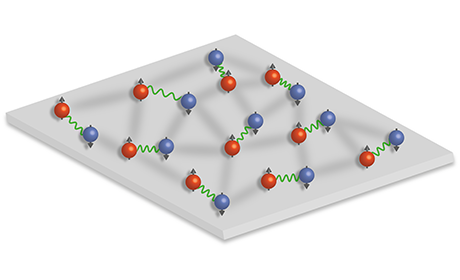2D Superconductivity: Fermion Pairing Observed At Higher Temperatures Than Before

A group of researchers has made an exciting quantum discovery that could propel us to superconductivity. They have synthesized a new state of matter where the constituent particles pair up when allowed to exist only in two dimensions.
The team from the Heidelberg University has created this new exotic state of matter in the quest to create a superconductor — a discovery with the potential of permanently changing the way we transfer electricity to and from modern day technology.
These materials, theoretically, have no resistance. Mercury was the first material that showed superconductive properties and is classified as a Type-I superconductor. When cooled below a certain critical temperature, these materials offer zero resistance to the flowing current.
In order for superconductivity to occur, the fermions (particles that follow Fermi-Dirac statistics) must pair up. When these materials are found to have superconducting properties at high temperatures tend to have layered structures.
“This means that electrons in these systems can only move in two-dimensional planes,” Prof. Dr. Selim Jochim, lead author of the study from Heidelberg University’s Institute for Physics said in a press release on their website. “What we did not understand until now was how the interplay of pairing and dimensionality can lead to higher critical temperatures.”
Using focused laser beams, researchers performed experiments in which they confined a gas of ultracold atoms in two-dimensional traps. This caused fermions to pair up.
“In solid-state materials like copper oxides, there are many different effects and impurities that make these materials difficult to study. That is why we use ultracold atoms to simulate the behavior of electrons in solids. This allows us to create very clean samples and gives us full control over the essential system parameters,” Puneet Murthy, a Ph.D. student at the Center for Quantum Dynamics at Heidelberg University and one of the lead authors of this publication said.
Using a technique known as radio-frequency spectroscopy (the same technology that is used in MRI machines in hospitals worldwide), the researchers measured the response of the atoms to a radio-wave pulse.
The reaction to the radio pulse told the team if the fermions were paired and how they were aligned on the surface of the 2D structure. The fermions could be tested on various strength and type of interactions.
Now, the team of researchers combined these fermions at a much higher temperature than theoretically calculated, possibly paving way for future superconducting.
Before this, scientists thought that fermions with a weak interaction would pair up at a very cold temperature to become superconductive. However, when the scientists increased the interaction between fermions using lasers, they found that pairing occurred at temperatures several times higher than the critical temperature.
“To achieve our ultimate goal of better understanding these phenomena, we will start with small systems that we put together atom by atom,” Prof. Jochim said. The research project also involved scientists from Heidelberg University’s Institute for Theoretical Physics and from Simon Fraser University in Vancouver (Canada).
Superconductivity was discovered on April 8, 1911, by Heike Kamerlingh Onnes, who was studying the resistance of solid mercury at cryogenic temperatures using the recently produced liquid helium as a refrigerant. At the temperature of -452.11 F, he observed that the resistance abruptly disappeared. In the same experiment, he also observed the superfluid transition of helium at -455.71 F, without recognizing its significance.
© Copyright IBTimes 2024. All rights reserved.





















